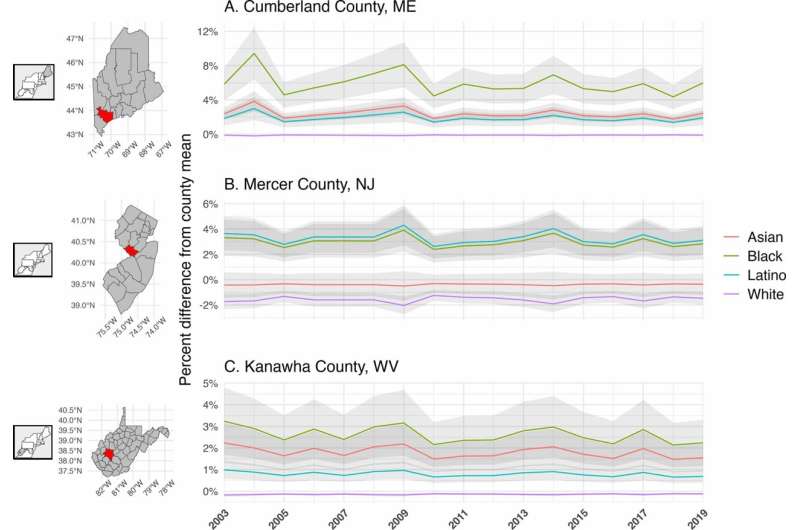This article has been reviewed according to Science X's editorial process and policies. Editors have highlighted the following attributes while ensuring the content's credibility:
fact-checked
peer-reviewed publication
trusted source
proofread
For some Black, Latino, and Asian people, summers are hotter

High summertime temperatures are contributing to health concerns associated with climate change, such as increased deaths from cardiovascular and chronic kidney diseases. But for Black, Latino, and some Asian people living in the Northeast and mid-Atlantic states, summers are hotter than for others, according to a new study from the Yale School of Public Health (YSPH).
The researchers found that Black and Latino people, and some Asian populations, consistently experience hotter warm seasons than non-Hispanic white people living in the same county. The results of their study suggest that residential segregation contributes to summer air temperature disparities.
Daniel Carrión, assistant professor of epidemiology (environmental health) and director of Education, Climate Change and Health, led the study published in Environmental Research Letters.
"We found that non-Hispanic Black and Latino people were consistently exposed to hotter warm seasons than would be expected if simply using the county average," the researchers wrote.
The study's results have potential ramifications for climate, health, and energy research and policy. "We hope these findings can support place-based interventions, including targeting of energy insecurity relief programs," the researchers said.
Climate change, heat, and poverty
Social disadvantage and temperature exposure are related, the researchers said. For example, urban heat islands are more prevalent in poor communities and communities of color.
Disparities in temperature exposures are a concern for several reasons. Black and Latino people are more vulnerable to negative health outcomes from exposure to hotter temperatures, which may be due to higher levels of comorbidities such as cardiovascular disease and chronic kidney disease. Also, air temperature estimates may underestimate exposures for vulnerable populations, so the effects of these exposures also may be underestimated, the authors wrote.
"Given that air conditioning is the dominant individual-level adaptive strategy to heat in the U.S., minoritized populations may have reduced adaptive capacity to climate change. Thus, extreme temperature exposures represent a form of underestimated structural racism in climate impacts," they added.
While there is growing recognition of summertime energy insecurity, few policies protect people who experience this hardship. The Low-Income Home Energy Assistance Program (LIHEAP) is one such protection program, but it distributes funding based on cold-season energy demand and provides less support during the warm season, the paper reported.
Programs like LIHEAP use statewide measures of energy demand, assuming people are exposed to the same hot temperatures. But as Black, Latino, and some Asian populations are exposed to hotter temperatures, their need for energy to cool their homes is underestimated, the authors emphasized.
Research method
The study sought to answer the question, "Do minoritized groups experience hotter summers than the area average, and do non-Hispanic white people experience cooler summers?" The researchers arrived at their conclusions by testing whether present-day measures of segregation are associated with summertime temperatures.
The researchers used a fine-scaled spatiotemporal air temperature model and U.S. census data from 2000 and 2010. Carrión and his colleagues focused on 13 states from Maine to Virginia, and Washington, D.C. The region they studied represented 17,733 census tracts in 434 counties, representing approximately 72.4 million people, according to the 2010 census.
Air temperature predictions were drawn from a geostatistical model. The researchers trained a machine learning model (XGBoost) on ground station data aggregated by the National Oceanic and Atmospheric Administration (NOAA) Meteorological Assimilation Data Ingest System (MADIS). The specific MADIS dataset that they used was the National Mesonet, with more than 4,000 weather stations across the region. They also aligned temperature data with census tracts.
More information: Daniel Carrión et al, Residential segregation and summertime air temperature across 13 northeastern U.S. states: potential implications for energy burden, Environmental Research Letters (2024). DOI: 10.1088/1748-9326/ad5b77
Journal information: Environmental Research Letters
Provided by Yale University



















